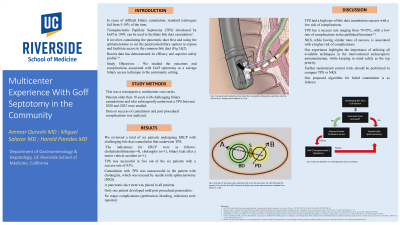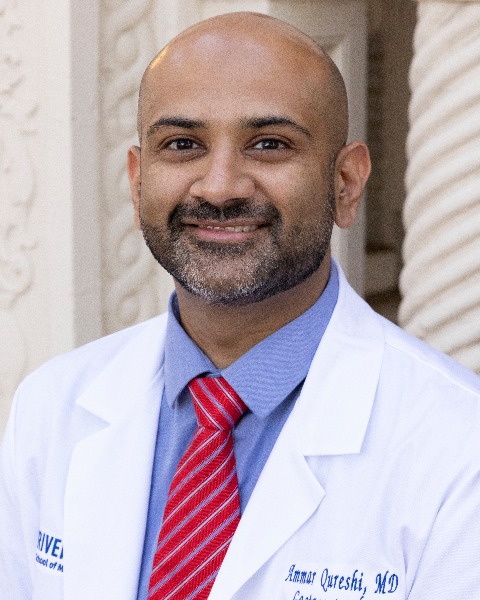Monday Poster Session
Category: Biliary/Pancreas
P1432 - Multicenter Experience With Goff Septotomy in the Community
Monday, October 23, 2023
10:30 AM - 4:15 PM PT
Location: Exhibit Hall

Has Audio

Ammar Qureshi, MD
University of California Riverside School of Medicine
Riverside, CA
Presenting Author(s)
Ammar Qureshi, MD1, Miguel Salazar, MD2, Harold Paredes, MD2
1University of California, Riverisde, Riverside, CA; 2University of California Riverside, Riverside, CA
Introduction: In cases of difficult biliary cannulation, standard techniques fail from 5-10% of the time. Transpancreatic papillary septotomy (TPS) introduced by Goff in 1995, can be used to facilitate bile duct cannulation. Recent data has demonstrated its efficacy and superior safety profile. We studied the outcomes and complications associated with Goff septotomy as a salvage biliary access technique in the community setting.
Methods: This was a retrospective, multicenter case series. We retrospectively studied patients older than 18 years with challenging biliary cannulations and who subsequently underwent a TPS between 2020 and 2023. Data on success of cannulation and post procedural complications was analyzed.
Results: We reviewed a total of six patients undergoing ERCP with challenging bile duct cannulation that underwent TPS. The indications for ERCP were as follows: 4 had choledocholithiasis, one had cholangitis, and the remaining patient had a biliary leak after a motor vehicle accident. TPS was successful in five out of the six patients with a success rate of 83%. Cannulation with TPS was unsuccessful in the patient with cholangitis, which was rescued by needle knife sphincterotomy (NKS). A pancreatic duct stent was placed in all patients. Only one patient developed mild post procedural pancreatitis. No major complications (perforation, bleeding, infection) were reported.
Discussion: In the above case series, TPS had a high rate of bile duct cannulation success with a low risk of complications. TPS has a success rate of greater than 83%, with a low rate of complications in the published literature. NKS, while having similar rates of success, is associated with a higher risk of complications. Given its safety profile, we propose the following algorithm for challenging bile duct cannulation: if the pancreatic duct can be accessed, we recommend attempts with double guidewire access. If double guidewire access fails, TPS should be attempted. Needle knife septotomy should be reserved for patients where the pancreatic duct is not accessed or potentially where TPS fails (as noted in one of our patients). Our experience highlights the importance of utilizing all available techniques in the interventional endoscopist's armamentarium, while keeping in mind safety as the top priority. Further randomized control trials should be performed to compare TPS vs NKS.
Disclosures:
Ammar Qureshi, MD1, Miguel Salazar, MD2, Harold Paredes, MD2. P1432 - Multicenter Experience With Goff Septotomy in the Community, ACG 2023 Annual Scientific Meeting Abstracts. Vancouver, BC, Canada: American College of Gastroenterology.
1University of California, Riverisde, Riverside, CA; 2University of California Riverside, Riverside, CA
Introduction: In cases of difficult biliary cannulation, standard techniques fail from 5-10% of the time. Transpancreatic papillary septotomy (TPS) introduced by Goff in 1995, can be used to facilitate bile duct cannulation. Recent data has demonstrated its efficacy and superior safety profile. We studied the outcomes and complications associated with Goff septotomy as a salvage biliary access technique in the community setting.
Methods: This was a retrospective, multicenter case series. We retrospectively studied patients older than 18 years with challenging biliary cannulations and who subsequently underwent a TPS between 2020 and 2023. Data on success of cannulation and post procedural complications was analyzed.
Results: We reviewed a total of six patients undergoing ERCP with challenging bile duct cannulation that underwent TPS. The indications for ERCP were as follows: 4 had choledocholithiasis, one had cholangitis, and the remaining patient had a biliary leak after a motor vehicle accident. TPS was successful in five out of the six patients with a success rate of 83%. Cannulation with TPS was unsuccessful in the patient with cholangitis, which was rescued by needle knife sphincterotomy (NKS). A pancreatic duct stent was placed in all patients. Only one patient developed mild post procedural pancreatitis. No major complications (perforation, bleeding, infection) were reported.
Discussion: In the above case series, TPS had a high rate of bile duct cannulation success with a low risk of complications. TPS has a success rate of greater than 83%, with a low rate of complications in the published literature. NKS, while having similar rates of success, is associated with a higher risk of complications. Given its safety profile, we propose the following algorithm for challenging bile duct cannulation: if the pancreatic duct can be accessed, we recommend attempts with double guidewire access. If double guidewire access fails, TPS should be attempted. Needle knife septotomy should be reserved for patients where the pancreatic duct is not accessed or potentially where TPS fails (as noted in one of our patients). Our experience highlights the importance of utilizing all available techniques in the interventional endoscopist's armamentarium, while keeping in mind safety as the top priority. Further randomized control trials should be performed to compare TPS vs NKS.
Disclosures:
Ammar Qureshi indicated no relevant financial relationships.
Miguel Salazar indicated no relevant financial relationships.
Harold Paredes indicated no relevant financial relationships.
Ammar Qureshi, MD1, Miguel Salazar, MD2, Harold Paredes, MD2. P1432 - Multicenter Experience With Goff Septotomy in the Community, ACG 2023 Annual Scientific Meeting Abstracts. Vancouver, BC, Canada: American College of Gastroenterology.
